Are you looking for a way to achieve that stunning black icing for your cakes and cupcakes without resorting to artificial food coloring? Look no further! FOODS.EDU.VN presents a comprehensive guide on making natural black icing, exploring various techniques and the secret ingredient that will transform your baking creations. Discover the best methods for achieving a deep, rich black hue while keeping your ingredients wholesome and your desserts visually appealing. Learn about alternatives to food dyes and explore natural food coloring options for vibrant and safe decorating.
1. Understanding the Challenge: Achieving Black Icing Naturally
Creating black icing without artificial food coloring can seem like a daunting task. Traditional methods often rely on large amounts of food coloring, which can alter the taste and texture of your icing. However, with the right techniques and ingredients, it’s entirely possible to achieve a beautiful, deep black color naturally. Let’s delve into the challenges and explore effective solutions.
- The Problem with Food Coloring: Artificial food colorings have raised concerns due to potential allergic reactions and hyperactivity in some individuals. Many bakers and consumers are now seeking natural alternatives that don’t compromise on aesthetics or flavor.
- The Quest for Natural Black: The color black is particularly challenging to achieve in food using natural ingredients. Most natural dyes tend to produce muted or brownish shades, making it difficult to replicate the intense black achieved with artificial colors.
- Taste Alteration: Using excessive amounts of any coloring agent, whether artificial or natural, can affect the taste of the icing. It’s crucial to find a method that delivers the desired color without making the icing bitter or unpleasant.
2. The Secret Ingredient: Black Cocoa Powder
The key to achieving naturally black icing lies in a special ingredient: black cocoa powder. Unlike regular cocoa powder, black cocoa powder has been heavily Dutch-processed, resulting in a significantly darker color and a unique, almost Oreo-like flavor. This makes it the perfect base for creating black icing without any artificial additives.
- What is Black Cocoa Powder? Black cocoa powder is essentially raw cacao powder that undergoes a Dutch process, where it is treated with an alkaline solution to reduce acidity. This process darkens the cocoa and gives it a smoother, less bitter flavor.
- Why Black Cocoa Works: The intense darkness of black cocoa powder allows you to achieve a deep black color in your icing without needing to add any artificial dyes. It provides a natural and flavorful way to transform your buttercream or other icings.
- Flavor Profile: Black cocoa powder imparts a distinct flavor reminiscent of Oreo cookies. This flavor complements many cake and cupcake recipes, adding a delicious twist to your desserts.
3. Choosing the Right Black Cocoa Powder Brand
Not all black cocoa powders are created equal. The darkness and intensity of the color can vary significantly between brands. To ensure you achieve the best possible results, it’s essential to choose a high-quality, extra-dark black cocoa powder.
| Brand | Darkness Level | Flavor Profile | Availability | Price |
|---|---|---|---|---|
| Hershey’s | Medium | Mild, slightly bitter | Widely Available | Affordable |
| King Arthur Baking | Dark | Rich, chocolatey | Online & Stores | Moderate |
| Penzey’s | Extra Dark | Intense, Oreo-like | Online & Stores | Premium |
| Guittard | Dark | Smooth, well-balanced | Online & Specialty Stores | Moderate |
| Valrhona | Very Dark | Complex, fruity undertones | Online & Specialty Stores | High End |




- Look for “Extra Dark”: When shopping for black cocoa powder, look for labels that specifically indicate “extra dark” or “black” cocoa. These powders have undergone more extensive processing and will deliver a much deeper color.
- Read Reviews: Check online reviews and recommendations from other bakers to find reliable brands. Experimenting with different brands can help you discover your personal favorite.
- Consider Availability: Depending on your location, some brands may be easier to find than others. Online retailers often offer a wider selection of black cocoa powders.
4. The Ultimate Recipe: Black Buttercream Without Food Coloring
Here’s a simple yet effective recipe for creating luscious black buttercream without any artificial food coloring, brought to you by FOODS.EDU.VN.
Ingredients:
- 1 cup (226g) unsalted butter, room temperature
- 2 ½ cups (300g) powdered sugar
- ½ cup (56g) extra dark black cocoa powder
- 1 teaspoon pure vanilla extract
- 2 tablespoons whole milk, room temperature
- Pinch of salt
Instructions:
- Whip the Butter: In a stand mixer fitted with a paddle attachment, whip the butter on medium speed until creamy and light in color, about 4 minutes. This step is crucial for creating a smooth and airy buttercream.
- Add Powdered Sugar: Scrape down the bowl and paddle, then add half of the powdered sugar. Mix on low speed until just incorporated, then add the rest of the powdered sugar. Mixing on low prevents the sugar from flying everywhere.
- Incorporate Black Cocoa: With the mixer still in the off position, sift in the black cocoa powder and add the vanilla, milk, and salt. Sifting the cocoa powder ensures there are no lumps in your buttercream.
- Combine Ingredients: Mix on low until all ingredients are thoroughly combined, about 2 minutes, scraping down the bowl and paddle as needed. Be patient and allow the ingredients to fully incorporate for a smooth consistency.
- Let it Deepen: Place the buttercream in an airtight container and allow the color to deepen for 24 hours or more. You can keep it at room temperature for one day or store it in the refrigerator for up to two weeks. Allowing the buttercream to sit enhances the color and flavor.
- Rewhip Before Using: When you’re ready to use it, bring it back to room temperature and re-mix with your stand mixer on low speed until the consistency is smooth. This will ensure your buttercream is perfect for frosting.
5. Tips and Tricks for Perfect Black Icing
Achieving the perfect black icing requires attention to detail and a few insider tips. Here are some techniques to ensure your icing turns out flawlessly.
- Sifting is Key: Always sift your black cocoa powder before adding it to the buttercream. This prevents lumps and ensures a smooth, even color.
- Room Temperature Ingredients: Using room temperature butter and milk is essential for creating a stable emulsion. Cold ingredients can cause the buttercream to separate.
- Mix on Low Speed: Mixing on low speed prevents air bubbles and ensures the ingredients are thoroughly combined without overmixing.
- Patience is a Virtue: Allowing the buttercream to sit for 24 hours or more is crucial for the color to fully develop. Don’t rush the process for the best results.
- Adjust Consistency: If your buttercream is too thick, add a small amount of milk (1 tablespoon at a time) until you reach the desired consistency. If it’s too thin, add a bit more powdered sugar.
- Flavor Enhancements: Consider adding a touch of espresso powder or a pinch of black salt to enhance the flavor and deepen the color of your buttercream.
6. Exploring Other Natural Coloring Agents
While black cocoa powder is the star of the show for achieving black icing, it’s worth exploring other natural coloring agents that can be used in combination or for different shades.
| Natural Coloring Agent | Color Achieved | Best Used For | Notes |
|---|---|---|---|
| Beetroot Powder | Pink to Red | Cakes, frostings | Adds a subtle earthy flavor; use sparingly to avoid affecting the taste. |
| Matcha Powder | Green | Cakes, frostings, teas | Offers a slightly grassy flavor; use high-quality matcha for the best color and taste. |
| Turmeric Powder | Yellow | Cakes, frostings | Use sparingly as it can be overpowering; pairs well with warm spices. |
| Butterfly Pea Flower | Blue to Purple | Drinks, frostings | Can change color based on pH levels; use lemon juice to shift towards purple. |
| Activated Charcoal | Black | Frostings, desserts | Use food-grade activated charcoal; be mindful of the texture and potential grittiness. Consult your doctor before use. |
| Spirulina Powder | Blue-Green | Smoothies, frostings | Offers a vibrant color and nutritional benefits; use sparingly due to its distinct flavor. |
| Carrot Juice | Orange | Cakes, frostings | Adds a subtle sweetness; reduce other liquids in the recipe to maintain consistency. |
| Spinach Juice | Green | Cakes, frostings | Use sparingly to avoid a strong flavor; best used in combination with other flavors. |
| Red Cabbage | Purple to Blue | Pickling, coloring | Boil red cabbage and use the water as a natural dye. The color can vary depending on the pH of the solution. |
| Annatto Seeds | Orange to Red | Cheese, rice | Infuse oil or water with annatto seeds to extract color. Use the infused liquid or oil in your recipe for a natural orange or red hue. |
- Activated Charcoal: Food-grade activated charcoal can be used to achieve a deep black color. However, it’s essential to use it sparingly, as it can affect the texture and flavor of your icing. Additionally, consult with a healthcare professional before using, as it can interfere with medication absorption.
- Beetroot Powder: Beetroot powder can create beautiful shades of pink and red. It’s best used in small amounts to avoid affecting the taste.
- Matcha Powder: For green hues, matcha powder is an excellent choice. It adds a subtle earthy flavor that complements many desserts.
- Spirulina: Spirulina powder can create vibrant blue and green shades. Like matcha, it has a distinct flavor, so use it sparingly.
7. Troubleshooting Common Issues
Even with the best recipes and techniques, you might encounter a few challenges along the way. Here are some common issues and how to address them.
- Icing is Not Dark Enough: If your icing isn’t as dark as you’d like, ensure you’re using extra-dark black cocoa powder. Allowing the icing to sit for 24 hours or more can also help deepen the color.
- Icing Tastes Bitter: If the icing tastes bitter, you may have used too much black cocoa powder. Try adding a touch of vanilla extract or a pinch of salt to balance the flavor.
- Icing is Too Thin: If your icing is too thin, add a bit more powdered sugar, one tablespoon at a time, until you reach the desired consistency.
- Icing is Too Thick: If your icing is too thick, add a small amount of milk (1 teaspoon at a time) until it thins out.
- Icing is Grainy: Grainy icing is often caused by undissolved powdered sugar. Ensure you’re mixing the ingredients thoroughly and that the powdered sugar is fresh and finely ground.
8. Recipe Variations and Creative Ideas
Once you’ve mastered the basic black buttercream recipe, the possibilities are endless. Here are some variations and creative ideas to inspire your baking.
- Oreo Buttercream: For an even more intense Oreo flavor, add crushed Oreo cookies to your black buttercream.
- Chocolate Black Buttercream: Melt dark chocolate and fold it into your black buttercream for a richer, more decadent flavor.
- Mint Chocolate Black Buttercream: Add mint extract to your black buttercream for a refreshing twist.
- Espresso Black Buttercream: Incorporate espresso powder or strong brewed coffee into your black buttercream for a mocha-flavored treat.
- Vegan Black Buttercream: Use vegan butter and milk alternatives to create a dairy-free version of this recipe.
9. Perfect Pairings: Cakes and Cupcakes
Black buttercream pairs beautifully with a variety of cakes and cupcakes. Here are some suggestions for creating stunning and delicious desserts.
- Black Velvet Cake: Black buttercream is the perfect complement to black velvet cake, enhancing the dark, rich flavor and creating a visually striking dessert.
- Vanilla Cake: The contrast between the dark buttercream and a light vanilla cake is both visually appealing and delicious.
- Chocolate Cupcakes: Elevate chocolate cupcakes with a swirl of black buttercream for a sophisticated treat.
- Red Velvet Cake: The deep red of red velvet cake pairs beautifully with the dark black buttercream, creating a dramatic and flavorful combination.
- Lemon Cake: The bright, citrusy flavor of lemon cake is a delightful contrast to the rich, chocolatey notes of black buttercream.
10. The Science Behind Black Cocoa
Understanding the science behind black cocoa powder can help you appreciate its unique properties and how it contributes to achieving black icing naturally.
- Dutch Processing: The Dutch process involves treating cocoa beans with an alkaline solution, which neutralizes their acidity. This process darkens the cocoa, reduces its bitterness, and alters its flavor profile.
- Maillard Reaction: The Maillard reaction is a chemical reaction between amino acids and reducing sugars that occurs during heating. This reaction contributes to the browning and flavor development in baked goods, including those made with black cocoa powder.
- Color Intensity: The intensity of the color in black cocoa powder is due to the high degree of oxidation that occurs during the Dutch process. This oxidation creates melanoidins, which are responsible for the dark brown and black pigments.
11. Storing Black Buttercream
Proper storage is essential for maintaining the quality and color of your black buttercream. Here are some tips for storing it correctly.
- Airtight Container: Store the buttercream in an airtight container to prevent it from drying out or absorbing odors from the refrigerator.
- Room Temperature: Black buttercream can be stored at room temperature for up to 1 day. However, it’s best to refrigerate it for longer storage.
- Refrigeration: Black buttercream can be stored in the refrigerator for up to 2 weeks. Bring it back to room temperature and rewhip it before using.
- Freezing: For longer storage, black buttercream can be frozen for up to 3 months. Thaw it in the refrigerator overnight and rewhip it before using.
12. Health and Safety Considerations
When working with natural coloring agents, it’s essential to consider health and safety aspects.
- Allergies: Be aware of potential allergies to natural ingredients. For example, some individuals may be allergic to beetroot, matcha, or spirulina.
- Interactions: Some natural ingredients, such as activated charcoal, can interact with medications. Consult with a healthcare professional before using them.
- Food-Grade Products: Always use food-grade products when working with natural coloring agents. Avoid using craft or cosmetic-grade products in your baking.
- Storage: Store natural coloring agents properly to prevent spoilage or contamination. Follow the manufacturer’s instructions for storage.
13. Black Icing for Special Occasions
Black icing is perfect for a variety of special occasions, adding a touch of elegance and sophistication to your desserts.
- Halloween: Create spooky Halloween treats with black buttercream, such as spiderweb cupcakes or haunted house cakes.
- Gothic Weddings: Black icing is a popular choice for gothic-themed weddings, adding a dramatic and romantic touch to wedding cakes.
- Birthday Parties: Surprise your guests with a black velvet cake adorned with black buttercream for a memorable birthday celebration.
- Corporate Events: Black icing can be used to create elegant and professional desserts for corporate events, adding a touch of sophistication to your brand.
- Themed Parties: Use black icing to complement the theme of your party, whether it’s a superhero celebration or a masquerade ball.
14. Expert Tips from Professional Bakers
To provide you with the best possible advice, we’ve gathered expert tips from professional bakers on how to achieve perfect black icing without food coloring.
- Use High-Quality Ingredients: Professional bakers emphasize the importance of using high-quality ingredients, especially black cocoa powder.
- Don’t Overmix: Overmixing buttercream can result in a dense, greasy texture. Mix until just combined for the best results.
- Experiment with Flavors: Professional bakers often experiment with different flavors to create unique and delicious buttercream variations.
- Practice Makes Perfect: Don’t be discouraged if your first attempt isn’t perfect. Practice and experimentation are key to mastering the art of black icing.
- Stay Updated: Keep up with the latest trends and techniques in the baking industry to stay ahead of the game.
15. Frequently Asked Questions (FAQ)
Q1: Can I use regular cocoa powder instead of black cocoa powder?
No, regular cocoa powder won’t provide the deep black color you’re looking for. Black cocoa powder is essential for achieving the desired hue.
Q2: Does black cocoa powder taste different from regular cocoa powder?
Yes, black cocoa powder has a distinct flavor reminiscent of Oreo cookies. It’s less bitter than regular cocoa powder and adds a unique twist to your desserts.
Q3: Can I use this recipe for other types of icing?
Yes, you can adapt this recipe for other types of icing, such as cream cheese frosting or ganache. Just adjust the ingredients accordingly.
Q4: How can I make vegan black buttercream?
Use vegan butter and milk alternatives to create a dairy-free version of this recipe.
Q5: Can I add other flavors to black buttercream?
Absolutely! Experiment with different extracts, spices, and ingredients to create unique and delicious buttercream variations.
Q6: How do I prevent my black buttercream from turning my teeth black?
This recipe is designed to minimize teeth staining. However, consuming large amounts of any dark-colored food can temporarily stain your teeth.
Q7: Can I use activated charcoal instead of black cocoa powder?
Yes, but use food-grade activated charcoal sparingly, as it can affect the texture and flavor of your icing. Consult with a healthcare professional before using.
Q8: How long does black buttercream last?
Black buttercream can be stored at room temperature for up to 1 day, in the refrigerator for up to 2 weeks, or in the freezer for up to 3 months.
Q9: Why is my black buttercream turning brown?
Exposure to air and light can cause black buttercream to fade or turn brown. Store it in an airtight container in a dark, cool place to prevent this.
Q10: Where can I buy extra dark black cocoa powder?
Extra dark black cocoa powder can be found online, at specialty baking stores, and in some well-stocked supermarkets.
16. The Importance of Experimentation
Baking is both a science and an art, and experimentation is key to developing your skills and creating unique and delicious desserts. Don’t be afraid to try new ingredients, techniques, and flavor combinations. The more you experiment, the more you’ll learn about the art of baking.
- Try Different Brands: Experiment with different brands of black cocoa powder to find your personal favorite.
- Adjust Sweetness: Adjust the amount of powdered sugar in the recipe to suit your taste preferences.
- Incorporate Flavors: Incorporate different extracts, spices, and ingredients to create unique and exciting flavor combinations.
- Adjust Consistency: Adjust the amount of liquid in the recipe to achieve the perfect buttercream consistency.
- Get Creative: Get creative with your decorations and designs, and let your imagination run wild.
17. Additional Resources and Learning Opportunities
To further enhance your baking skills and knowledge, we’ve compiled a list of additional resources and learning opportunities.
- Online Baking Courses: Take online baking courses to learn new techniques and recipes from professional bakers.
- Baking Books: Explore baking books to discover new recipes, tips, and tricks.
- Baking Blogs: Follow baking blogs for inspiration, tutorials, and expert advice.
- Baking Workshops: Attend baking workshops to learn hands-on skills and techniques from experienced instructors.
- Baking Communities: Join online baking communities to connect with other bakers, share ideas, and ask questions.
18. The Future of Natural Food Coloring
As consumers become more health-conscious and aware of the potential risks associated with artificial food colorings, the demand for natural alternatives is growing. The future of natural food coloring is bright, with ongoing research and development leading to new and innovative solutions.
- Plant-Based Dyes: Plant-based dyes derived from fruits, vegetables, and flowers are becoming increasingly popular.
- Microbial Pigments: Microbial pigments produced by microorganisms offer a sustainable and scalable alternative to traditional dyes.
- Enzymatic Color Modification: Enzymatic processes can be used to modify the color of natural compounds, creating a wider range of hues.
- Nanotechnology: Nanotechnology is being explored as a way to enhance the stability and intensity of natural food colorings.
- Sustainable Sourcing: Sustainable sourcing practices are becoming increasingly important to ensure the ethical and environmental responsibility of natural food coloring production.
19. Stay Connected with FOODS.EDU.VN
At FOODS.EDU.VN, we’re committed to providing you with the best culinary knowledge and resources. We encourage you to explore our website for more articles, recipes, and tips on baking, cooking, and everything food-related.
- Subscribe to Our Newsletter: Subscribe to our newsletter to stay updated on the latest news, recipes, and trends in the culinary world.
- Follow Us on Social Media: Follow us on social media to connect with us and other food enthusiasts.
- Share Your Creations: Share your baking creations with us on social media using the hashtag #FOODSEDU.
- Contact Us: Contact us with any questions, comments, or suggestions. We’d love to hear from you!
Address: 1946 Campus Dr, Hyde Park, NY 12538, United States
Whatsapp: +1 845-452-9600
Website: FOODS.EDU.VN
20. Conclusion: Embrace the Art of Natural Baking
Creating black icing without food coloring is a rewarding and satisfying experience. By using black cocoa powder and following our tips and techniques, you can achieve a stunning, deep black color naturally. Embrace the art of natural baking and create delicious and visually appealing desserts that are both wholesome and beautiful. We at FOODS.EDU.VN are here to guide you every step of the way.
Ready to elevate your baking skills and discover more exciting culinary secrets? Visit FOODS.EDU.VN today for a wealth of knowledge, expert tips, and mouthwatering recipes. Let us help you unlock your culinary potential and create unforgettable dishes that will impress your family and friends! Discover the joy of natural baking and explore the endless possibilities that await you at foods.edu.vn.
